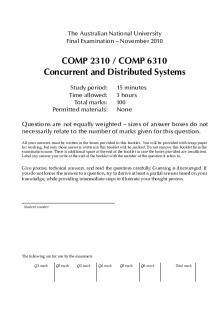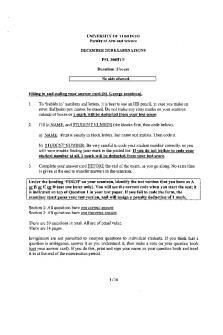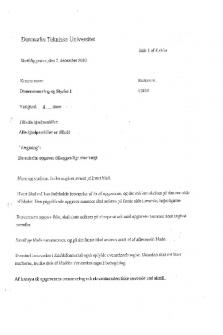Exam 2010, questions PDF

| Title | Exam 2010, questions |
|---|---|
| Course | MBCHB1 Coursework |
| Institution | University of Glasgow |
| Pages | 25 |
| File Size | 549.2 KB |
| File Type | |
| Total Downloads | 58 |
| Total Views | 146 |
Summary
Download Exam 2010, questions PDF
Description
Candidate Number -
MBChB 1 Examination Paper 1 May 25th 2010 9.30 a.m. – 11.30 a.m. This paper is in two parts • Part A
Modified Essay Question
60 minutes
• Part B
Short Notes
60 minutes
Instructions to Candidates Two hours will be allowed to complete this exam. This examination is in two parts. The examiners recommend that students divide their time between the parts as follows: Part A Part B
Modified Essay Question Short Notes
Part A
60 minutes 60 minutes
Modified Essay Question
1. One hour is recommended for the completion of Part A. 2. This part carries 60 marks. 3. DO NOT read through this booklet before starting. 4. On each page of the exam, information is provided about a developing scenario. Read through the information at the top of the page then answer the question(s) on that page. You should write short, succinct answers but if you need more space please use the back of the sheet. 5. If you are asked to answer a question by drawing a diagram, you must do this to earn the marks. 6. Each page should be labelled clearly with your registration number and candidate number. 7. Each page will be marked by a different examiner therefore do not assume that the examiner marking any one page will be aware of anything you have written on a previous page. Try to make each answer “free-standing”. 8. The time you should spend on each answer and the time remaining is indicated on each page. Try to keep to the suggested timings. 9. The number of marks for each section is indicated on each page.
Registration Number
Part A
Candidate Number
Modified Essay Question
The Battle of the Bulge Don and Ann are in their early sixties. One night in bed Don noticed a bulge on his abdomen, pulsing in time with his heartbeat. Don made an appointment to see his GP who informed him that his symptoms were “most likely due to a bulge in his main abdominal artery”. Name Layers A, B and C in this diagram of the wall of the aorta. 3 marks
A-
B-
C-
Name the cells lining the inner surface of layer A and outline their value in aortic function. 2 marks
Name the principal connective tissue fibres in layer B and outline their value in aortic function. 2 marks
What risk do you think this bulge (an aortic aneurysm) would pose? 1 mark
Marks Awarded = 8 marks
Time Remaining = 52 minutes
1
continued overleaf
Registration Number
Candidate Number
Don was admitted to hospital to confirm the diagnosis and to plan for a surgical repair. Using your knowledge of investigations of blood vessel disease, name two noninvasive imaging techniques which could be used to determine the location and dimensions of the distended aorta. 2 marks
Marks Awarded = 2 marks
Time Remaining = 50 minutes
2
continued overleaf
Registration Number
Candidate Number
The bulge was located in the lower abdomen in the midline. Surgical repair was planned for four weeks later. Don was interested in his treatment but not expert. He was very pleased with the surgeon’s explanations but he asked for some clarification of the following in layman’s (simpler) terms. How would you (as the doctor) explain the following terms? Atheroma Thrombocytopenia
Omentum Retroperitoneal 4 marks
Marks Awarded = 4 marks
Time Remaining = 46 minutes
3
continued overleaf
Registration Number
Candidate Number
Two days before the operation Don attended hospital for pre-operative checks. A blood sample was taken for grouping and cross-matching. Describe the ABO blood group system. 2 marks
Explain how and why blood is cross matched for the surgery to the patient's aorta 2 marks
Marks Awarded = 4 marks
Time Remaining = 42 minutes
4
continued overleaf
Registration Number
Candidate Number
The aneurysm had been located at the lower end of the abdominal aorta. A long incision was made vertically in the mid-line, the full length of the anterior abdominal wall. The diagram below shows a mid-abdominal horizontal section. Name the layers A, B, C and D cut by this incision. 2 marks mid-line incision
A-
B-
C-
D-
Marks Awarded = 2 marks
Time Remaining = 40 minutes
5
continued overleaf
Registration Number
Candidate Number
Don’s heart functioned normally during the operation. The bulge was by-passed by inserting a cannula and the aorta clamped above and below the bulge. Why is it essential to provide the by-pass? 1 mark
Using your knowledge of the factors controlling blood pressure, explain why this bypass will put more strain on the heart? 2 mark
Marks awarded = 3 marks
Time remaining = 37 minutes
6
continued overleaf
Registration Number
Candidate Number
The bulge was slit length-wise and some of the tissue removed. A polyester cylinder was inserted in the aorta. The plastic had been coated with a layer of a phospholipid to minimise the risk of an inflammatory response Label the following diagram of a natural phospholipid molecule.
1 mark
Describe the basic features of the inflammatory response. 5 marks
Marks awarded = 6 marks
Time remaining = 31 minutes
7
continued overleaf
Registration Number
Candidate Number
Two days after the operation, Don develops a painful swollen left calf. The doctor diagnoses thrombosis in the veins of Don’s calf (deep venous thrombosis). He is initially treated with subcutaneous heparin and then subsequently with warfarin. Complete the following diagram of the blood coagulation cascade by filling the empty boxes. Only the pathway names are required in the larger, shaded boxes. Do not put in individual factors in the larger shaded boxes. 8 marks
Damage tissue
Activated Platelet
Clot Lysis/Removal
Explain how warfarin works.
2 marks
Marks Awarded = 10 marks
Time Remaining = 21 minutes
8
continued overleaf
Registration Number
Candidate Number
Five days later Don was home and mobile. He was doing well but he had developed a cough. What is the purpose of a cough? 1 mark
In the following diagram, name A, B, C and D involved in the cough reflex. 2 marks
A
D B
C
A-
B-
C-
D-
Marks awarded = 3 marks
Time remaining = 18 minutes
9
continued overleaf
Registration Number
Candidate Number
The GP suspected a bacterial infection of the respiratory tract and prescribed an oral antibiotic.
Describe the structure of a bacterial cell (a clear labelled diagram would be acceptable). 3 marks
In general terms, how do bacteria cause infection? 4 marks
Explain 2 mechanisms by which antibiotics work. 4 marks
Marks awarded = 11 marks
Time remaining = 7 minutes
10
continued overleaf
Registration Number
Candidate Number
The GP also sends a specimen to the local microbiology lab for identification. What type of specimen would be collected (1 mark)? How would the causative agent be isolated (1mark) and identified (1 mark)? 3 marks
Marks awarded = 3 marks
Time remaining = 4 minutes
11
continued overleaf
Registration Number
Candidate Number
Before surgery, Don had been consented to be involved in a research project looking at survival after aortic aneurysm repair. What type of research methodology is most likely to be used? 1 mark
In general, what circumstances are most likely to lead to a falsely favourable impression of the effectiveness of a treatment? 3 marks
Marks awarded = 4 marks
Time remaining = 0 minutes
12
continued overleaf
Registration Number
Part B
Candidate Number
Short Notes
1. One hour is allowed for the completion of part B. 2. Each short note is worth 12 marks (60 marks in total for part B). 3. Answer all the questions in this section. 4. All answers should be written on the paper in the space below the question. Use the continuation sheet if you need more room.
13
continued overleaf
Registration Number
Part B
Candidate Number
Short Note Questions
Each Short Note is worth 12 marks 1.
Describe the macroscopic and microscopic features of an adult long bone, like the femur (8 marks). At the distal aspect of the femur is the knee joint which is a synovial joint. Provide a simple diagram of a synovial joint (4 marks).
14
continued overleaf
Registration Number
Candidate Number
Question 1 Answer Continued
15
continued overleaf
Registration Number
2.
Candidate Number
What pathophysiological changes take place in the airways during the development of asthma. (2 marks) Asthmatic attacks can often be brought on by either allergens or other risk factors. Give two examples of each, for both potential allergens and other risk factors (2 marks). The inflammatory component of asthma suggests immunological involvement. Describe the immune response to an allergen. (4 marks) What immune cells are regularly seen in airways of an asthma sufferer (2 marks)? What treatment would you consider for an asthma sufferer? (2 marks)
16
continued overleaf
Registration Number
Candidate Number
Question 2 Answer Continued
17
continued overleaf
Registration Number
Candidate Number
3. Describe both individual (6 marks) and population (6 marks) approaches to the prevention of coronary heart disease.
18
continued overleaf
Registration Number
Candidate Number
Question 3 Answer Continued
19
continued overleaf
Registration Number
Candidate Number
4. Write brief notes on these three cell types; for each one, describe four characteristic features of the cell and indicate how these allow the cell to fulfil its particular function. Myelinated neurone Oocyte Spermatozoan
20
continued overleaf
Registration Number
Candidate Number
Question 4 Answer Continued
21
continued overleaf
Registration Number 5.
Candidate Number
Describe a synapse and the normal action of neurotransmitters (8 marks). Select two drugs of abuse, state which class of drugs they belong to and explain how they affect neurotransmitter mechanisms (4 marks).
22
continued overleaf
Registration Number
Candidate Number
Question 5 Answer Continued
END OF PAPER
23...
Similar Free PDFs

Exam 2010, questions
- 2 Pages

Exam 2010-2014, questions
- 6 Pages

Exam 2010, questions
- 20 Pages

Exam June 2010, questions
- 10 Pages

Exam 2010, questions
- 25 Pages

Exam June 2010, questions
- 10 Pages

Exam 2010, questions
- 2 Pages

Exam 2010, questions
- 3 Pages

Exam December 2010, questions
- 14 Pages

Exam 2010, questions
- 3 Pages

Exam 17 November 2010, questions
- 4 Pages

Exam 14 July 2010, questions
- 6 Pages

Exam 2010, questions and answers
- 5 Pages

Exam 2010, questions and answers
- 20 Pages

Exam 7 December 2010, questions
- 4 Pages
Popular Institutions
- Tinajero National High School - Annex
- Politeknik Caltex Riau
- Yokohama City University
- SGT University
- University of Al-Qadisiyah
- Divine Word College of Vigan
- Techniek College Rotterdam
- Universidade de Santiago
- Universiti Teknologi MARA Cawangan Johor Kampus Pasir Gudang
- Poltekkes Kemenkes Yogyakarta
- Baguio City National High School
- Colegio san marcos
- preparatoria uno
- Centro de Bachillerato Tecnológico Industrial y de Servicios No. 107
- Dalian Maritime University
- Quang Trung Secondary School
- Colegio Tecnológico en Informática
- Corporación Regional de Educación Superior
- Grupo CEDVA
- Dar Al Uloom University
- Centro de Estudios Preuniversitarios de la Universidad Nacional de Ingeniería
- 上智大学
- Aakash International School, Nuna Majara
- San Felipe Neri Catholic School
- Kang Chiao International School - New Taipei City
- Misamis Occidental National High School
- Institución Educativa Escuela Normal Juan Ladrilleros
- Kolehiyo ng Pantukan
- Batanes State College
- Instituto Continental
- Sekolah Menengah Kejuruan Kesehatan Kaltara (Tarakan)
- Colegio de La Inmaculada Concepcion - Cebu
